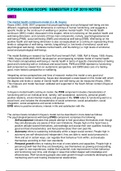IOP2604 EXAM SCOPE SEMESTER 2 OF 2019 NOTES
UNIT 1
The mental health continuum model (C.L.M. Keyes)
Keyes (2002, 2005, 2007) proposes that psychopathology and sychological well-being are two
different, negatively correlated dimensions or continua of human functioning, and suggests a
specific model on the continuum of wellbeing or positive mental health. This mental health
continuum (MHC) model, discussed in this chapter, refers to functioning on the positive health and
well-being dimension, and consists of three main components, namely, psychological/personal
well-being (PWB), social well-being (SWB) and emotional well-being (EWB). Well-being on the
positive health and well-being dimension is also conceptualised on a continuum representing three
levels or categories of well-being, namely, languishing (i.e. low levels of emotional, social and
psychological well-being), moderate mental health, and flourishing (i.e. high levels of emotional,
social and psychological well-being).
The model Building on research by Carol Ryff and himself (Ryff, 1989; Ryff & Keyes, 1995; Keyes,
1998), Keyes (2002,2005,2007) developed an encompassing complete model of mental health.
This model conceptualises well-being or mental health in terms of specific characteristics of feeling
good and functioning well on individual and social levels. PWB and SWB represent a functioning-
well component as viewed from an eudaimonic perspective, and EWB takes care of a feeling-
good, more hedonic perspective on wellbeing.
Integrating various perspectives and lines of research makes this model a very good and
comprehensive model of well-being. Keyes also developed a scale based on this model with which
the degree and levels or states of mental health and well-being can be measured (Keyes, 2006).
This measure and model has been validated and supported in the South African context (Keyes et
al., 2008).
In Keyes’s mental health continuum model, the PWB component includes characteristics of
functioning well on an individual level, namely, self-acceptance, autonomy, personal growth,
positive relations, environmental mastery and purpose in life. SWB refers to functioning well on a
social level, and includes the characteristics of social coherence, social actualisation, social
integration, social acceptance and social contribution.
EWB refers to positive emotions, interest in life and satisfaction with life.
The various facets included in Keyes’s model can be described in more detail as follows:
The psychological/personal well-being (PWB) component comprises the following:
• Self-acceptance indicates that people attempt to feel good about themselves even though
they simultaneously are aware of their own limitations. People high on this facet have a
positive attitude toward themselves, acknowledge and accept their own qualities including
good and bad characteristics, and feel positive about their own past life.
Autonomy refers to sustaining individuality within a larger social context. People high in
autonomy are self-directed and independent, they are able to resist social pressures to
think and act in certain ways, can regulate their behaviour from within, and evaluate
themselves according to their own standards.
• Personal growth refers to making the most of ones talents and capacities. People high in
personal growth feel that they are developing, see themselves as growing and expanding,
are open to new experiences, realise their potential, note improvement in their behaviour
and functioning over time, and change in ways that reflect deeper self-knowledge and
effectiveness. Well-functioning people also seek growth through constantly developing and
maintaining warm and trusting interpersonal relationships.
, • People high in positive relations have warm, trusting and satisfying relationships with
other people; are concerned about the well-being of others; show strong empathy, affection
and intimacy; and understand the give-and-take of human relationships.
• Environmental mastery refers to the capacity to shape own environments to meet
personal needs and desires. Someone with a high capacity for environmental mastery has
a sense of competence in managing the environment, can control many and complex
external activities, can make good use of resources and opportunities, and is able to select
or create contexts suitable to personal values and needs. An important aspect of well-being
is to experience meaning in life and in one’s efforts and challenges.
• High-functioning individuals have a strong sense of purpose in life, which refers to a sense
of directedness and through the pursuit of specific goals that are in line with beliefs and
values. Such individuals also tend to experience meaning in life (see also Chapter 3).
The social well-being (SWB) component includes the following facets:
• Social coherence refers to interest in social life and society, and the experience that social
processes are more or less comprehensible and meaningful.
• Social actualisation refers to beliefs that people, groups and societies have potential, and
can grow and evolve positively.
• Social integration refers to a sense of belonging to as well as a sense of support from a
community.
• Social acceptance refers to the degree to which a person has positive attitudes towards
others while accepting individual differences and complexities.
• Social contribution means that an individual sees his or her own daily activities as valued
by and useful to society and others.
The emotional well-being (EWB) component consists of the following:
• Having positive emotions (i.e. being generally cheerful, happy and calm)
. Being interested in life (i.e. being in good spirits and full of life)
• Experiencing life satisfaction (i.e. being mostly satisfied with life overall or in domains of life
in particular) (Keyes, 2006, 2007)
THE IMPACT OF WORK AND UNEMPLOYMENT ON PSYCHOLOGICAL ADJUSTMENT




